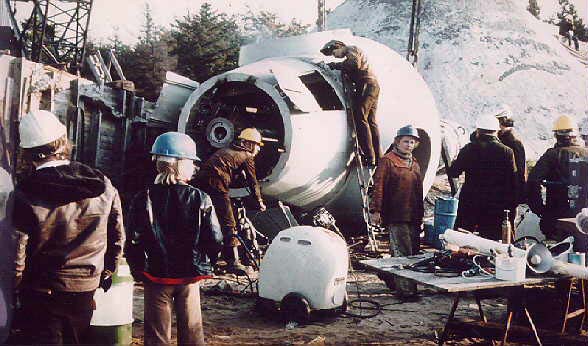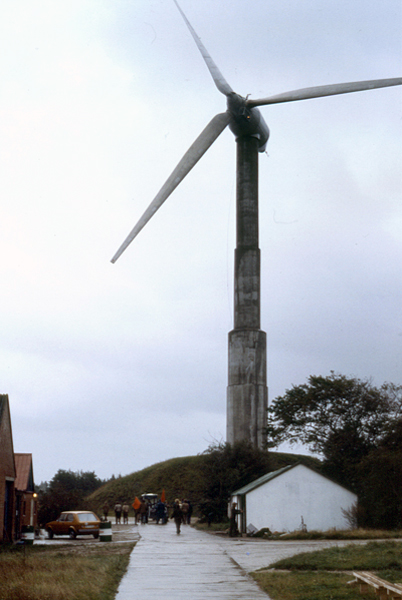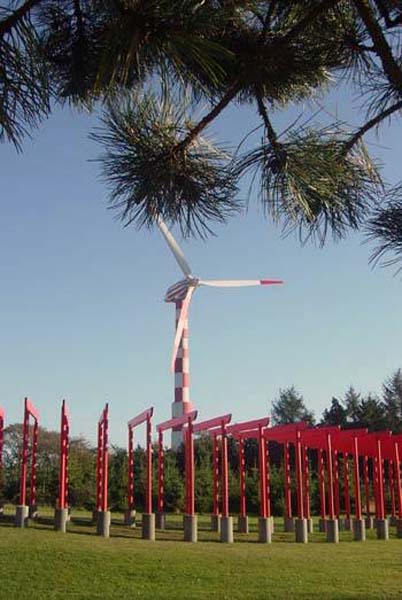Tvindkraft Windmill
Some history...
 The Tvind windmill, "Tvindkraft" was created during the years 1975-78, at the initiative of and financed by the teacher group of the schools at Tvind. The time was the time of the oil crisis, and the debate was for or against nuclear power - for or against wind power - nuclear power or wind power. The price of energy had multiplied, and something had to be done. The Danish industry was pressing on to introduce nuclear power as a cheap alternative to the expensive oil. A majority in the Danish Parliament was building up. At Tvind people were against the nuclear power, with its problems of nuclear waste and monopolization.
The Tvind windmill, "Tvindkraft" was created during the years 1975-78, at the initiative of and financed by the teacher group of the schools at Tvind. The time was the time of the oil crisis, and the debate was for or against nuclear power - for or against wind power - nuclear power or wind power. The price of energy had multiplied, and something had to be done. The Danish industry was pressing on to introduce nuclear power as a cheap alternative to the expensive oil. A majority in the Danish Parliament was building up. At Tvind people were against the nuclear power, with its problems of nuclear waste and monopolization.
Wind energy was common sense. There is lots of wind in Western Jutland. The wind cannot be monopolized - it blows on the poor as well as on the rich - and there are no dangerous waste products. So the idea was formed and turned into a decision to build a windmill. Tvindkraft had to be big, a proof of wind power being a real alternative to nuclear power.
And as a matter of fact, Denmark never got nuclear power, and thereby the natural environment in this country was saved from the big, and as of yet unsolved, problems of nuclear waste.
It took three years to build Tvindkraft. "Mølleholdet" ["The Mill Team"] was the implementing force, and consisted of members of Tvind’s Teacher Group and a long row of volunteers who by their labour wished to participate in this vigorous demonstration in the energy debate. They solved the difficulties which arose along the way, and through tireless work they erected the windmill: the excavation and the foundation, the tower that slid upward in its gliding form, the cap and the hub with its complicated welding. The blades, which no manufacturer dared commit themselves to producing, and where aerodynamics, calculations of strength as well as practical execution had to be developed from scratch.
The shaft, gearbox and generator were bought second hand, and "Krabbe’s box" [the frequency converter control box] was put together by professor Ulrich Krabbe from DTH [Denmark’s Technical University] and his students, who got themselves a really good final examination task. It was used for converting the varying frequency of the generator, so that the mill could deliver power to the power grid. Computer control and supervision systems were developed, and long assembly language programs were written for the Z80-computer. And finally, the large cranes arrived and hoisted all the parts up. First the cap, and then the generator and gear box on top, the main shaft with the hub, and finally the blades, one at the time. Like that.
The Danes were flocking to see what was happening, to voice their opinions and give good advice and encouragement. Many gave a hand in shorter or longer periods, others got a cup of tea and then left again - assured that something groundbreaking was taking place, something which would have a tremendous impact on the future. In 1977, when the construction was about to finish, 77,000 people passed by in a two-month period.
Tvindkraft was created to show the way forward for wind energy - and to show the way out for nuclear power. But the most important thing was probably that the Teacher Group showed that it was possible for normal people, without any significant scientific education, to build a large wind power plant. With their determination, their drive, their elbow grease and common sense, cooperation and support, where help was to be found, this unparalleled structure was created - despite comments like: "You are doing wind power a disservice by trying to build a windmill", and despite the fact that no authority wanted to give any financial assistance to the windmill construction, although it clearly followed the recommendations of the ‘Akademiet for Teknisk Videnskaber’ [Academy for Technical Sciences] to promote the development of wind energy in Denmark, with both practical experiments as well as research projects.
There were almost two separate, but parallel, development processes for wind energy inside this small country.
One process was the private initiative
 Everywhere windmills began to pop up, with Tvindkraft as the biggest. Denmark already had good traditions for using wind power for electricity production. Johannes Juul from SEAS [Sjællands Elecktricitets Aktieselskab - Electricity Producers of Sealand, Inc.] had developed the Bogø-mill in 1953, and in ’57 the Gedser-mill started running. Both windmills used three blades, a moderate revolving speed with stall regulation, directly coupled with an asynchronous generator and an active yawing system - a rotational system for positioning the windmill into or out of the wind - a concept which was based on common sense and practical experiences, and which later came to make up the backbone of the Danish windmill industry.
Everywhere windmills began to pop up, with Tvindkraft as the biggest. Denmark already had good traditions for using wind power for electricity production. Johannes Juul from SEAS [Sjællands Elecktricitets Aktieselskab - Electricity Producers of Sealand, Inc.] had developed the Bogø-mill in 1953, and in ’57 the Gedser-mill started running. Both windmills used three blades, a moderate revolving speed with stall regulation, directly coupled with an asynchronous generator and an active yawing system - a rotational system for positioning the windmill into or out of the wind - a concept which was based on common sense and practical experiences, and which later came to make up the backbone of the Danish windmill industry.
The other process was the Danish national energy programme
Preben Maegaard from the ‘Folkecenteret for Vedvarende Energi’ [Nordic Folkecenter for Renewable Energy] describes in a summary how the ‘Akademiet for Teknisk Videnskaber’s’ above-mentioned recommendation for wind energy was put into practice. "If wind energy was to become reality, something completely else had to be done" - was the clear tendency. Real research had to be done, and it could not be carried out by just anybody. A consortium was created by a number of industrial enterprises. And now windmills would be developed.
The first ones to result from the wind power program of the Ministry of Trade’s and the energy companies were the two Nibe-mills. Unfortunately the choice was made not to build on previously gained experiences - neither Danish nor foreign. A totally essential part of a windmill is its blades, and Denmark had neither industry nor research institutions with any particular knowledge of aerodynamics.
The situation is different in countries with an airplane industry - there they would be able to construct a windmill blade, also of a large size. But the Danish wind power program did not ask in those places, and it had sad consequences for the results of the Nibe-mills.
One mill was given fibreglass blades in combination with some very cleverly welded steel constructions, which actually could not be verified with regard to the condition of the constantly varying strain occurring in a rotor. The other windmill had a load-bearing inner beam of fibreglass, which did not last long despite a large-scale and expensive development effort.
Few years later both mills were given wooden blades, which after a lightning damage were replaced by blades from Vestas.
How did the Mill Team at Tvind handle the task with the blades?
 First of all, they admitted the fact that they didn’t have any understanding whatsoever of blades, and therefore looked for help where help was to be found. One place was Stuttgart, where professor Ulrich Hütter had many years of experience with fibreglass blades, and a special technique where fibreglass cables were wrapped around the hub bolts. This technique was used for the blades on Tvindkraft.
First of all, they admitted the fact that they didn’t have any understanding whatsoever of blades, and therefore looked for help where help was to be found. One place was Stuttgart, where professor Ulrich Hütter had many years of experience with fibreglass blades, and a special technique where fibreglass cables were wrapped around the hub bolts. This technique was used for the blades on Tvindkraft.
The Mill Team constructed "the sausage machine" and the fibreglass sausages were stretched out along the whole length of the blade, and around the blade bolts. Then sausage upon sausage was added until the blade was completed, was carried out by everybody at Tvind, and could be hoisted up into its place.
Preben Maegaard emphasizes that this was later used as an example of a good technique. The same technique was used for the small PTG-mill, [PTG = Practical Theoretical Vocational Education] also developed at Tvind (where the mould was later lent out to interested mill builders). Later on the technique was used for the "Økær-blades", a company which became the first supplier of blades to the budding windmill industry. Other industrial production forms have since then been developed and made progress.
Many do-it-yourself builders built their own windmills, and there was an obvious foundation for starting an industrial production. The windmill industry has gradually developed into Denmark’s second largest export industry, and Denmark has for many years been among the most influential in the field of wind energy.
And we are proud of the fact that it was the Mill Team at Tvind who brought Hütter’s technique to Denmark, who built some very large blades which could last, and who demonstrated that building modern windmills actually could be done.
Henrik Stiesdal, the technical director for the wind mill producer Bonus Energy, who visited Tvind for the first time in 1976 and who has worked with wind energy ever since, says to the magazine ‘Ingeniøren’ [The Engineer]:
"The effect of the Tvind mill as a source of inspiration cannot be overstated. A large number of the pioneers became hooked, like me, on the possibilities and practical challenges of wind power when they visited Tvind. The almost nonchalant self-confidence with which the Mill Team built something no one had ever done before was very contagious.
Added to this is the fact that some of the first tools were developed at Tvind, partly physical tools like the blade moulds for 4,5 meter blades, suitable for do-it-yourself mills, and partly measuring tools and instruction manuals. The existence of the ‘Vestjysk Energikontor’ [The West Jutland Energy Office], created in connection with the mill project, was also essential.
The Tvind mill was not the only concrete inspiration. Similarly inspiring was Christian Riisager from Skærbæk at Herning, who in 1976 erected the first privately owned electricity producing windmill. With its 22 kW-output compared to the 2 MW of the Tvind mill, Riisager’s mill was a more realistic prototype. One could say that Riisager’s mill showed the concrete and practical way, whereas the Tvind mill indicated the overall potentials.
And I think it is interesting that we today market windmills which have exactly the same basic dimensions as the Tvind mill has - 54 m. rotational diameter, for example the Bonus’ 1 MW mill type."
Today there are approximately 6,000 wind mills in Denmark, and they produced app. 4,500 Gwh of electricity in the year 2000. This was 13% of Denmark's electricity consumption. This means that 1,4 million tons of carbon did not get burnt off, and the natural environment was spared 4 million tons of pollution. Thus one has to conclude that Tvindkraft both directly and indirectly has had a decisive importance for the protection of the natural environment.
When Tvindkraft produces power, it relieves the environment?
In round figures, Tvindkraft produced 10 million kilowatt hours of energy during its first 15 years.
If the same amount of energy had been produced in an ordinary power plant, this would mean the burning of 3000 tons of coal.
This burning would pollute the environment with:
8,200 tons carbon dioxide (CO2)
15 tons sulphur dioxide (SO2)
15 tons nitrogen oxides (NOx)
550 tons cinder and fly ash
In Total 8,870 tons of pollutants
(The 3,000 tons of coal actually turns into many more tons of pollution, since the carbon combines with oxygen and forms carbon dioxide, CO2)




